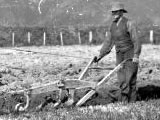What happened that day?
See historic events for any day of the year by entering the date below. Why not try your birthday?
Kiwi of the Week
Today in History

1897 NZ's first woman doctor registered
On 3 May 1897 Margaret Cruickshank became the first woman to be registered as a doctor in New Zealand. She practised in Waimate, South Canterbury, until 1918, when she died during the influenza pandemic.
Margaret studied medicine at the University of Otago Medical School. And in 1897 she became the second woman in New Zealand to complete a medical course - a year after her friend Emily Siedeberg. She became New Zealand's first registered woman doctor after accepting a position as assistant to Dr H. C. Barclay of Waimate. Apart from a year's study in Britain in 1913, she worked in Waimate for the rest of her life, eventually becoming a partner in the practice.
Margaret was modest about her achievements. But she did briefly comment on them when explaining her reluctance to be interviewed to a journalist with White Ribbon in 1900:
Though I may have had a little of what the world calls success, I am on a very lowly rung of the ladder yet, and from such have a very circumscribed outlook so that I feel myself hardly fitted to speak very dogmatically about questions affect women practitioners.
She did emphasise that she had not faced hostility from male medical practitioners in New Zealand.
Margaret was held in great esteem in her community. Following her death during the 1918 influenza pandemic the people of Waimate unveiled a memorial statue to her, inscribed 'The Beloved Physician/Faithful unto Death'.
Internal links

1820 First European plough used in NZ
The missionary John Butler turned the first furrow at Kerikeri, recording: 'I trust that this day will be remembered with gratitude, and its anniversary kept by ages yet unborn.'
Butler, New Zealand's first ordained resident clergyman, arrived at the Bay of Islands in August 1819 as superintendent designate of the Church Missionary Society's mission. He was accompanied by his wife and two children, and James Kemp, a lay missionary, and his wife. The Butlers and Kemps took up residence at Kerikeri, which became Butler’s headquarters as the superintendent of the mission.
Butler's journal of his years at Kerikeri provides not only details of his contacts with Maori but also an insight into contemporary Maori culture. A key aspect of the missionaries' work was the introduction of European practices − including agricultural methods − that would help ‘civilise’ Maori and prepare them for conversion. On 3 May 1820 Butler wrote:
‘The agricultural plough was for the first time put into the land of New Zealand at Kideekidee, and I felt much pleasure in holding it after a team of six bullocks… I trust that this day will be remembered with gratitude, and its anniversary kept by ages yet unborn. Each heart rejoiced in this auspicious day, and said, “May God speed the plough’”.














